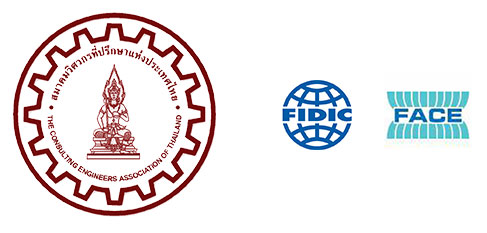Project Name: Passenger Terminal Complex, Suvarnabhumi Airport
Consultant: ACT Consultants Co., Ltd.
Responsible for detailed design of interior architecture, structural concrete, mechanical and electrical systems and preparation of Tender Documents.
Other Partners:
- Murphy/Jahn, Inc. of Chicago, USA Responsible for overall planning, conceptual design, architecture and detailed design of enclosure.
- TAMS Consultants, Inc. of New York, USA Responsible for planning and design of aviation related systems and preliminary design of mechanical and electrical systems.
- Werner Sobek Ingenieure GmbH, Stuttgart Subconsultant responsible for structural steel design of the Concourse and Terminal Roof Louver.
- Martin/Martin, Inc. Colorado, USA Subconsultant responsible for structural steel design of the Terminal Roof.
- Nond-Trungjai Architects & Planners Co., Ltd., Bangkok Subconsultant responsible for interior design, Thai art and landscaping.
Project Owner: Airports of Thailand Public Co., Ltd.
Project Location: Amphoe Bangpli, Samuthprakarn, Thailand
Type, Size and Construction Cost: The Suvarnabhumi Airport Passenger Terminal Complex has constructed floor space of more than 600,000 square meter, comprising of the Main Terminal and Concourse with more than 560,000 square meter useable floor area, two multi-storey parking garages with 2,500 car capacity each and three levels of frontage roads. The tendered construction cost is more than 40 billions Thai Baht.
Highlight:
- The Terminal Roof Trusses: The Terminal Building Roof is spanned by 210m long super trusses that permit a 441m by 109m column-free Check-In Hall. The trusses have central spans between supporting pylons of 126m with cantilever spans of 42m on both sides. The trusses have variable cross-sections with two compression chords and one tension chords, their depth roughly follows the bending moment diagram. Thetrusses are fabricated from steel plates up to 100mm thick, and weigh between 1,200 to 1,550 tons each.
![3 6]()
- The Terminal Glass Facade: The Terminal Building Glass Facade, about 1100 metre long by 30 metre high supported by cable-stayed posts and pretensioned cable trusses, is one of the largest in the world. Each glass light is 2.25 metre wide by 2.45 metre high 10mm + 10mm laminated heat strengthen glass, fixed to the support by 4-legged stainless steel spiders.
- The Concourse Roof Trusses: The Concourse roof is supported on a series of curved 5-pin trusses, spanning the width of the Concourse (40.25m). The trusses are fabricated from extruded tubular steel of various diameters and thickness. Each set of 5-Pin Truss weighs more than 150 tons.
- The Fabric Membrane: About two-third of the Concourse enclosure is cladded with fabric membrane that is designed to provide not only the normal weather exclusion but also excellent barrier to heat and aircraft noises. The membrane also allow high quality diffused natural light that makes electrical lighting unnecessary during the day. The Fabric Membrane is comprised of three layers.
![5 2]() The outer layer, fabricated from PTFE coated woven glass-fibre fabric, provides protection from solar radiation and other climateelements. The smooth PTFE coating makes this outer layer effectively self cleaning. The middle layer, made from 6mm thick transparent polycarbonate sheets supported on steel cable netting, provides most of the aircraft engine noise attenuation.
The outer layer, fabricated from PTFE coated woven glass-fibre fabric, provides protection from solar radiation and other climateelements. The smooth PTFE coating makes this outer layer effectively self cleaning. The middle layer, made from 6mm thick transparent polycarbonate sheets supported on steel cable netting, provides most of the aircraft engine noise attenuation.
The inner layer, made from aluminized PTFE coated woven glass-fibre fabric, provides low emissivity (Low-E) surface to reduce infrared radiation into the building, as well as architectural ceiling finishes. - Radiant Floor Cooling System: Areas that are exposed to direct solar radiation through the enclosure are conditioned by a combination of radiant floor and low-velocity displacement air diffusers. Chilled water is pumped through PEX (cross-linked polyethylene) tubes embedded in the floor providing efficient removal of solar heat gains. The humidity is removed via the air diffusers. The low air speed allows effective stratification of the air space with the conditioned air limited to 4-meter above the floor.
- Gigabit Ethernet: Suvarnabhumi is the first airport to select Gigabit Ethernet as the main network technology for data, voice and video communication throughout the Passenger Terminal and the Airport.



 The outer layer, fabricated from PTFE coated woven glass-fibre fabric, provides protection from solar radiation and other climateelements. The smooth PTFE coating makes this outer layer effectively self cleaning. The middle layer, made from 6mm thick transparent polycarbonate sheets supported on steel cable netting, provides most of the aircraft engine noise attenuation.
The outer layer, fabricated from PTFE coated woven glass-fibre fabric, provides protection from solar radiation and other climateelements. The smooth PTFE coating makes this outer layer effectively self cleaning. The middle layer, made from 6mm thick transparent polycarbonate sheets supported on steel cable netting, provides most of the aircraft engine noise attenuation.